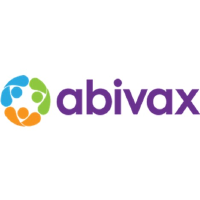Company Analysis ABIVAX Société Anonyme
1. Summary
Advantages
- The stock's return over the last year (519.91%) is higher than the sector average (-20.37%).
- Current debt level 47.44% is below 100% and has decreased over 5 years from 80.2%.
Disadvantages
- Price (68.5 $) is higher than fair price (42.58 $)
- Dividends (0%) are below the sector average (1.61%).
- The company's current efficiency (ROE=-148.98%) is lower than the sector average (ROE=14.32%)
Similar companies
2. Share price and performance
2.1. Share price
2.3. Market efficiency
| ABIVAX Société Anonyme | Healthcare | Index | |
|---|---|---|---|
| 7 days | -3.5% | 0.5% | 2% |
| 90 days | 840.9% | -23% | 9.8% |
| 1 year | 519.9% | -20.4% | 17.3% |
AAVXF vs Sector: ABIVAX Société Anonyme has outperformed the "Healthcare" sector by 540.28% over the past year.
AAVXF vs Market: ABIVAX Société Anonyme has outperformed the market by 502.59% over the past year.
Highly volatile price: AAVXF is significantly more volatile than the rest of the market on "OTC" over the last 3 months, with typical deviations of more than +/- 15% per week.
Long period: AAVXF with weekly volatility of 10% over the past year.
3. Summary of the report
4. Fundamental Analysis
4.1. Stock price and price forecast
Above fair price: The current price (68.5 $) is higher than the fair price (42.58 $).
Price is higher than fair: The current price (68.5 $) is 37.8% higher than the fair price.
4.2. P/E
P/E vs Sector: The company's P/E (-24.51) is lower than that of the sector as a whole (46.56).
P/E vs Market: The company's P/E (-24.51) is lower than that of the market as a whole (46.13).
4.3. P/BV
P/BV vs Sector: The company's P/BV (10.98) is higher than that of the sector as a whole (5.34).
P/BV vs Market: The company's P/BV (10.98) is higher than that of the market as a whole (4.36).
4.3.1 P/BV Similar companies
4.4. P/S
P/S vs Sector: The company's P/S indicator (41.28) is higher than that of the sector as a whole (4.29).
P/S vs Market: The company's P/S indicator (41.28) is higher than that of the market as a whole (12.96).
4.4.1 P/S Similar companies
4.5. EV/Ebitda
EV/Ebitda vs Sector: The company's EV/Ebitda (-2.32) is lower than that of the sector as a whole (17.57).
EV/Ebitda vs Market: The company's EV/Ebitda (-2.32) is lower than that of the market as a whole (27.25).
5. Profitability
5.1. Profitability and revenue
5.2. Earnings per share - EPS
5.3. Past profitability Net Income
Yield Trend: Rising and has grown by 73.87% over the last 5 years.
Earnings Slowdown: The last year's return (0%) is below the 5-year average return (73.87%).
Profitability vs Sector: The return for the last year (0%) exceeds the return for the sector (-1.77%).
5.4. ROE
ROE vs Sector: The company's ROE (-148.98%) is lower than that of the sector as a whole (14.32%).
ROE vs Market: The company's ROE (-148.98%) is lower than that of the market as a whole (52.17%).
5.5. ROA
ROA vs Sector: The company's ROA (-66.22%) is lower than that of the sector as a whole (7.27%).
ROA vs Market: The company's ROA (-66.22%) is lower than that of the market as a whole (36.33%).
5.6. ROIC
ROIC vs Sector: The company's ROIC (0%) is lower than that of the sector as a whole (14.12%).
ROIC vs Market: The company's ROIC (0%) is lower than that of the market as a whole (10.84%).
7. Dividends
7.1. Dividend yield vs Market
Low yield: The dividend yield of the company 0% is below the average for the sector '1.61%.
7.2. Stability and increase in payments
Unstable dividends: The company's dividend yield 0% has not been consistently paid over the past 7 years, DSI=0.
Weak dividend growth: The company's dividend yield 0% has been growing weakly or stagnant over the past 5 years. Growth over only 0 years.
7.3. Payout percentage
Dividend Coverage: Current payments from income (0%) are at an uncomfortable level.
Pay for your subscription
More functionality and data for company and portfolio analysis is available by subscription

 MAX Chat
MAX Chat

